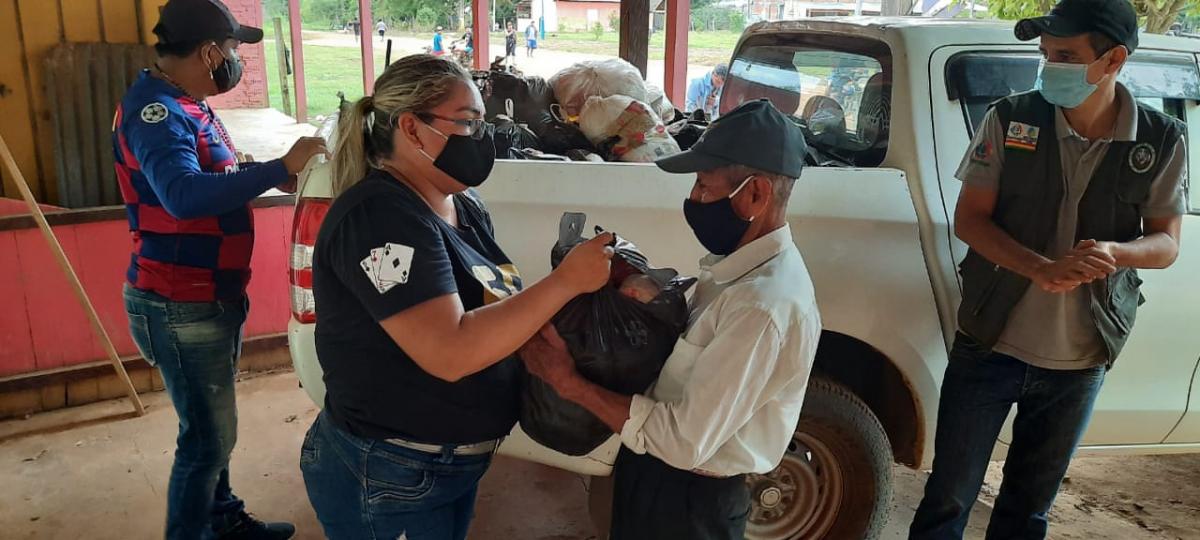The IUCN Green List, a key ally of local communities in protected areas facing the challenge of COVID-19
Local communities are key actors for the conservation and successful management of protected and conserved areas. With the emergence of COVID-19, the needs of local communities have been exacerbated and protected areas face threats that are difficult to counter in the current context.
The effects of COVID-19 are visible in the increase in illegal activities of exploitation of resources such as mining, logging, poaching, etc. A study published by WWF Germany indicates that, in March, deforestation in tropical forests in 18 countries increased by 150% compared to the average registered between 2017-2019 of the same month. This link between deforestation and COVID-19 responds to the restriction of patrolling and control activities in protected areas due to confinement measures.
Regarding the Amazon biome, and considering that around 70% of the of South American GDP is generated in the area of rains produced by the Amazon (Nobre, 2014)[1], another important front of the COVID-19 affectation is the economic one. This has resulted in massive job losses and, in turn, has meant a return to activities in rural areas, which implies the incursion into activities - legal and non-legal - of exploitation of natural resources. The implications of COVID-19 also affect peasants and populations dependent on agricultural activities to the extent that the commercialization of the sale of products has been limited by isolation restrictions. This is not a reality unrelated to the local communities that live in protected and conserved areas.
The Manuripi Amazon National Wildlife Reserve (RNVSA) in Bolivia, has an approximate area of 747,000 ha and has five main vegetation units of which almost 60% correspond to the Amazonian Chestnut Forest of the Center of Pando, therefore the presence of this non-timber forest species (Bertholletia excelsa) constitutes the most important natural resource of the protected area, its use being one of the most relevant aspects in its management. The RNVSA is home to 435 families from 10 peasant communities and 38 individual farms (barracas), which depend on the extraction of Brazil nuts as a subsistence economy based on migratory agriculture and temporary harvest. This population is extremely vulnerable since 70% of the family income comes exclusively from the sustainable use of the chestnut.
The COVID-19 emergency has seriously affected health (more than 95% of the population became infected in the first 6 months), as well as the livelihoods of these families due to: travel restrictions, lack of marketing, and limitations of the flow of goods and services. Despite the fact that chestnut production during the 2019-2020 harvest has reached 90% of production, there has been a sharp drop in sales prices, dragged down for a couple of years. With the health crisis, the price of Brazil nuts has suffered a much greater drop than anticipated, which means that many families have been left without sources of income.
Through the IUCN project, Fair and Effective Protected and Conserved Areas in the Amazon, known as the “Amazon Green List”, funded by the Gordon and Betty Moore Foundation, an emergency fund was created to support Green List areas in Peru and Bolivia. In the specific case of Bolivia, and at the request of the Board of Directors of the RNVSA Manuripi Management Committee, humanitarian aid (food packages) was provided to the families of Manuripi. The Management Committee, with the support of the Reserve Directorate and the presidents of the communities, acquired the supplies and organized the logistics for their delivery, a great example of inter-institutional coordination, dialogue and response to local needs.
German Gongora, President of the RNVSA Manuripi Management Committee, states that this: “has been a favorable support of encouragement and respite to moderately cover the problems of the family basket against hunger of the moment [..] it was possible to arrive with humanitarian aid to the community members of the protected area. This was very helpful to face the health emergency caused by COVID-19, where the community members have applauded that support has been reached and have not been forgotten by the authorities of the Communities”.
RNVSA Manuripi saw the governance of the area strengthened with the support of the Integration of Amazonian Protected Areas project, IAPA (2017-2019). The current President and Vice President of the Management Committee, as well as key personnel from SERNAP and the local communities, participated in the course on capacity building in natural resource governance, taught by IUCN and the Latin American School of Protected Areas of the University of Inter Cooperation
There have been several attempts by the protected area to get support from local government bodies, however, the health emergency has challenged the response capacity of these government agencies. For this reason, community leaders have joined efforts to strengthen local governance through the consolidation of the Amazon Fruit Pickers Association, a productive economic organization in the community of Villa Florida, articulated with the stakeholders of the Management Committee. of the RNVSA Manuripi, in which young people from each community have been trained as new leaders of good Governance in Protected Areas to face the socioeconomic consequences of the health crisis.
It should be noted that the IUCN Green List Standard recognizes that governance is a fundamental pillar to achieve successful conservation results in protected and conserved areas. From the IUCN regional office for South America, and with key donors such as the Gordon and Betty Moore Foundation, there is significant interest and efforts to rescue good governance practices in five countries in the Amazon region through the Amazon Green List project.
For more information, contact María Moreno de los Ríos, Coordinator of the Amazon Green List Project and Integration of Amazon Protected Areas (IAPA): maria.moreno@iucn.org
[1] Nobre, Antônio Donato (2014). O Futuro Climático da Amazônia: relatório de avaliação científica, Marco científico para salvar la Amazonía www.theamazonwewant.org





